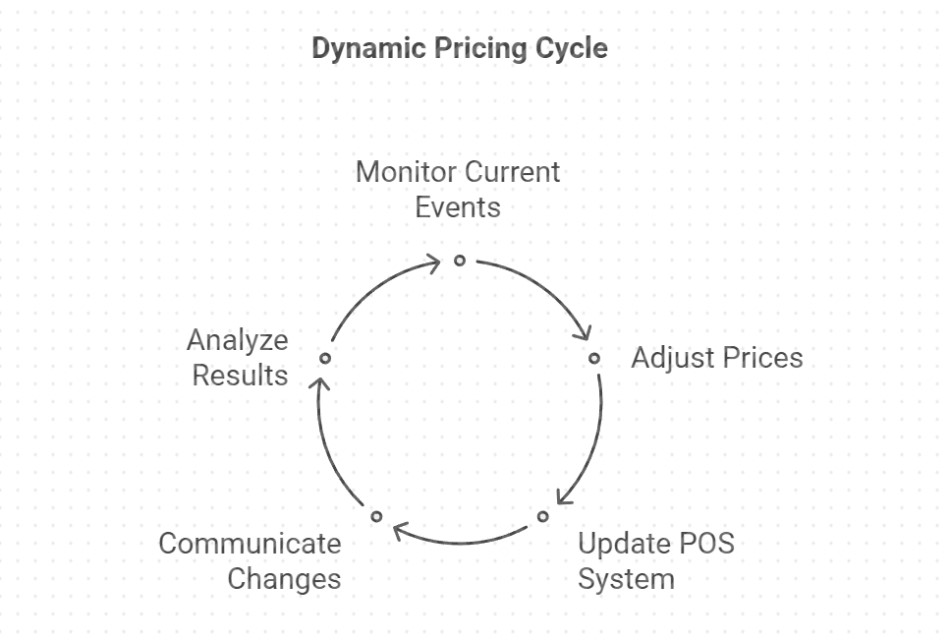
The right pricing strategy can make or break a shop's success. Have you ever considered dynamic pricing?
What is Dynamic Pricing?
Do you know how petrol prices change when you drive past the service station? That's dynamic pricing in action. It's all about tweaking your prices based on current events. That's dynamic pricing in action. It's all about tweaking your prices based on current events. Our POS system makes it dead easy to change prices on the fly.
It is all about being flexible
Real-World Applications
Here are some examples of what my clients do:
A Cafe
Let me illustrate a common scenario for a café owner. It's 2 p.m., and you've got sandwiches that will soon be binned. What do they do?
Here's what one of my clients does:
- Before 2 pm: Sandwiches sold at regular price
- After 2 pm: Offers a special deal on sandwich + coffee at a discounted rate
The result? Instead of binning unsold sandwiches with no margin, they turned potential zero into profit. It's a win-win: customers get a bargain, and the cafe boosts its afternoon sales.
A Hairdresser
- Morning Special: Discounted haircuts for seniors
This simple change increased foot traffic during slow hours and built loyalty among a key customer demographic.
Implementing Dynamic Pricing
You might think, "Sounds great, but isn't it a hassle to keep changing prices?" That's where modern POS systems come in. With the right software, price changes are a breeze.
The Power of POS
Here's how easy it can be:
- Open your POS system
- Navigate to the price change menu
- Select the items you want to adjust
- Enter the new price or discount
- Set the time frame for the special
- Hit apply
And voila! Your 'Happy Hour' special is ready to go.
The Benefits of Dynamic Pricing
From my experience, implementing dynamic pricing can lead to:
- Reduced waste: Sell perishable items before they expire
- Increased foot traffic: Attract customers during slow periods
- Higher overall profits: Maximise revenue by adjusting to demand
- Improved customer satisfaction: Offer value to price-sensitive customers
Tips for Success
Here are some lessons I've learned along the way:
- Start small: Test dynamic pricing on a few items first
- Communicate clearly: Make sure your staff and customers understand the specials
- Analyse results: Use your POS data to see what works and what doesn't
- Be flexible: Don't be afraid to adjust your strategy based on results
A Word of Caution
While dynamic pricing can be helpful, it's essential to use it properly.
FAQ: Dynamic Pricing in Australia
Q: What is dynamic pricing?
A: Dynamic pricing occurs when businesses adjust their prices based on current market demands, customer behaviour, and other factors. It involves changing prices in real time to maximize profits and stay competitive.
Q: What is an example of dynamic pricing?
A: One of the best-known examples is petrol pricing. Petrol stations adjust their prices based on time of day, traffic levels, and customer demand. During peak times or high-demand periods, prices can surge.
Q: Is dynamic pricing legal in Australia?
A: Yes, dynamic pricing is legal in Australia. The Australian Competition and Consumer Commission (ACCC) states that while forms of dynamic pricing exist in some markets, businesses must be clear about consumers' prices.
Q: Why is dynamic pricing considered good?
A: Dynamic pricing can be beneficial for several reasons:
- It can increase revenue by maximizing the value of each sale.
- It helps businesses grow market share by attracting more customers.
- It gives businesses more control over their pricing strategy.
- It can help prevent ticket scalping in event ticketing.
Q: Where is dynamic pricing commonly used in Australia?
A: In Australia, dynamic pricing is used in many businesses, including:
- Airlines
- Taxis services
- Hotels


